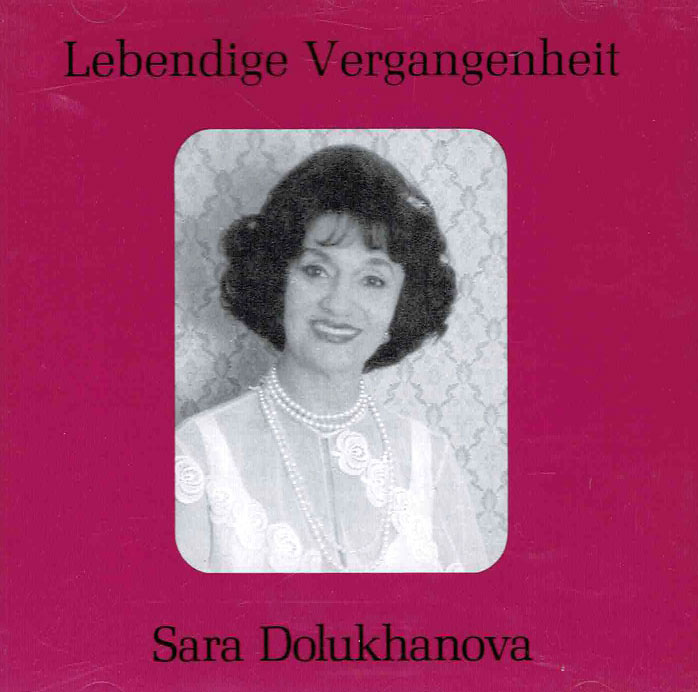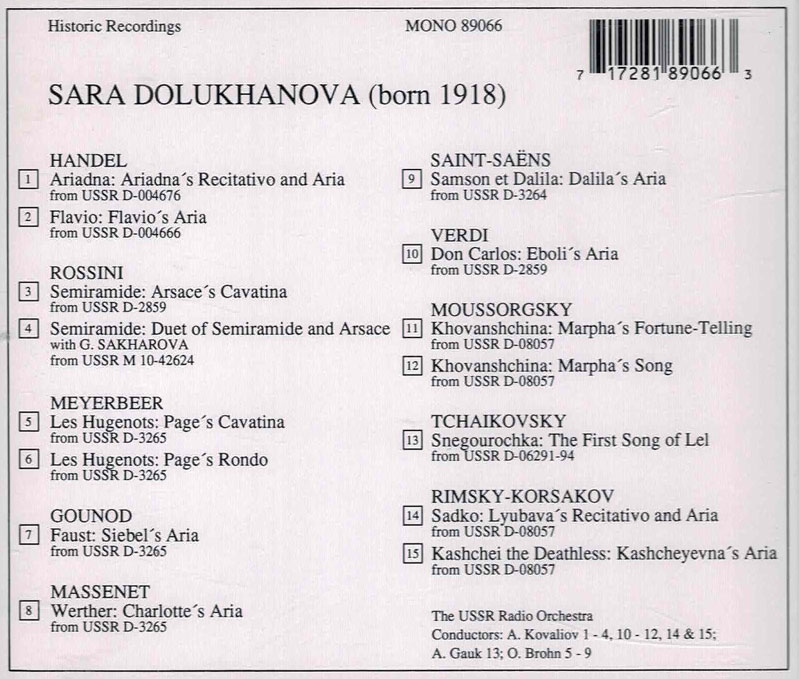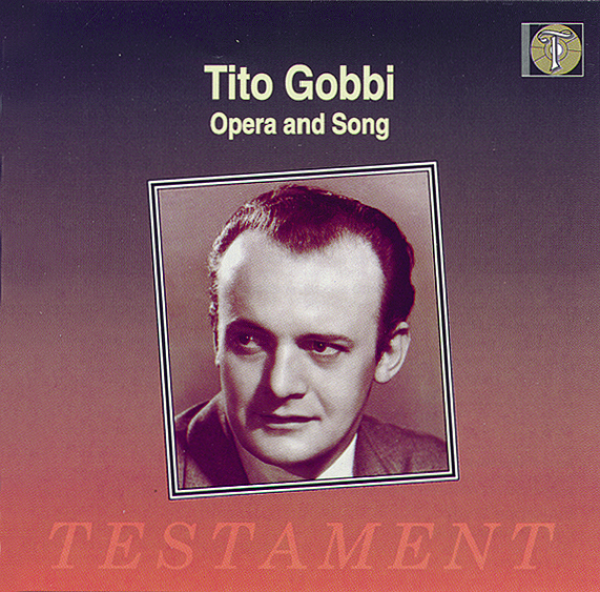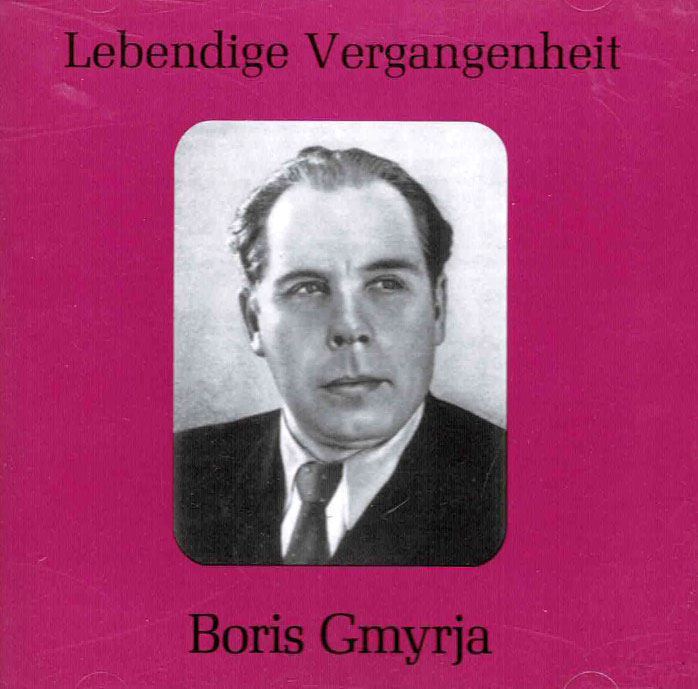Logowanie
Mikołaj - ten to ma gest!
Miles Davis, Horace Silver, Jay Jay Johnson, Percy Heath, Kenny Clarke, Lucky Thompson
Walkin'
20bit K2Super Coding - ale jak to brzmi!
Kasety magnetofonowe
Winylowy niezbędnik
ClearAudio
Double Matrix Professional - Sonic
najbardziej inteligentna i skuteczna pralka do płyt winylowych wszelkiego typu - całkowicie automatyczna
MEYERBEER, HANDEL, ROSSINI, GOUNOD
Sara Dolukhanova - Arias

- MEYERBEER
- HANDEL
- ROSSINI
- GOUNOD
Lebendige Vergangenheit
Tue mezzo soprano Sara Dolukhanova was born on 5 March 1918 in Moscow, to parents who were highly musical. Her father, an engineer by profession, played the piano and violin excellently. Her mother was regarded in her Armenian homeland as a very promising soprano; she was prevented only by family considerations from embarking on a singing career. Both parents saw to it that their daughter grew up with music. Sara began piano lessons at the age of five. At 13 she switched to the violin and was accepted by the respected Gnessin Musical Institute in Moscow, where her vocal capabilities were discovered three years later. After just a few years of study, the young mezzo soprano, not quite 19 years old and newly married, went to Armenia. She made her debut as Olga in Tchaikovsky's "Bugen Onegin" at the Spendiarov Opera and Ballett Theatre in Erivan in 1939. Despite the outbreak of World War II shortly thereafter, mu sic l life in Armenia was then flourishing, thanks to a number of artists who had returned to their homeland from Moscow. One of them was the famous baritone Pavel Lisitsian, who later became Sara Dolukhanova's brother-in-law. Tue three beginner's years she spent at the Opera in Erivan were rich in experience and impressions, though she appeared only in minor roles: Emilia in Verdi's "Otello", the Page in "Rigoletto", Dunyasha in Rimsky-Korsakov's "A Bride for the Tsar". This period was destined to remain an episode in Sara Dolukhanova's career, for when she went back to Moscow from Erivan in 1944 it marked the end of her work in opera - but it was the start of one of the most brilliant concert careers ever known in Russia. In Moscow she became an All Union Radio soloist. A little later she sang her first concert in her native city; it was conducted by Nikolai Golovanov, the music director of the Bolschoi Theatre for many years and one of the finest conductors Russia ever produced. In a very short time the young mezzo soprano won the public's respect and favor. From the start she was not content to present a colorful bouquet of pleasing, familiar songs and arias; on the contrary, she frequently put rarely played music on her programmes, placing special emphasis on contemporary Soviet composers such as Prokofiev, Shostakovitch, Miaskovsky, Sviridov and Shaporin. Several of them wrote songs or whole song cycles for her, suiting them to her particular vocal abilities. fu addition, she took part in almost all the opera productions that were broadcast by Moscow Radio. Two of them especially, Rossini's "La Cenerentola" and "L'Italiana in Algeri", in which she sang the title roles, are milestones in the performance tradition of western European operas in Russia. Since both recordings were issued by the state record company Melodiya, one can still be an ear-witness of the magnificent feats achieved by Sara Dolukhanova in the extremely difficult coloratura mezzo category. In 1949 Sara Dolukhanova scored her first big success outside Russia by winning first prize in an international singing competition in Budapest. After 1958, when she became a soloist with the Moscow Philharmonie, her career was no longer limited to her Russian homeland. She gave guest performances in 30 countries all over the world, among them Italy, France, England, Tue United States, Japan and New Zealand. She earned a reputation abroad first and foremost as the most outstanding interpreter of songs by Russian and Soviet composers, and of no less importance was her work in introducing songs by western European composers to Russia. For example, she was the first singer to perform there the "Four Last Songs" by Richard Strauss to poems by Hesse and Eichendorff. Although there was no lack of attractive offers to return to the operatic stage, that part of Sara Dolukhanova's career was over after the three years in Erivan. Tue management of London's Covent Garden opera, for example, tried to persuade her to do Amneris in "Aida" - without success. 1963 brought a surprising turning point in Sara Dolukhanova's vocal development: she changed from mezzo to soprano. Tue decision was not expected by any of the experts, for the change is usually the other way around, from soprano to mezzo. Tue shift of categories was clearly evident in her repertoire: she now took on such dramatic soprano roles as Norma, Aida, Tosca, Madame Butterfly, and also Mimi and Tatiana. She was especially successful in the title role of Puccini's one-act opera "Suor Angelica", which in 1969 was given its Russian premiere in a concert performance in the Grand Hall of the Moscow Conservatory. In 1969 SaraDolukhanova also celebrated the thirtieth anniversary of her first appearance on the stage. In contrast to most singers, she did not take the occasion to present the familiar plums from her standard repertoire. With a single exception, the programme consisted of music she had never sung before.


































